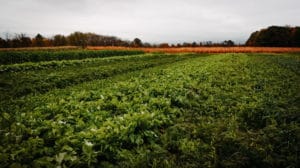Cover Crop Economics: Opportunities to Improve Your Bottom Line in Row Crops

A cover crop demo event co-hosted by the Cornell Soil Health Program and the American Farmland Trust.
Jenn Thomas-Murphy / Cornell University
Cover crops present a myriad of benefits to farmers in terms of soil health, weed suppression, improved water availability, and much more. The millions of acres of cover crops currently planted throughout the country are proof that they are becoming more and more attractive to growers in the United States. It is established that cover crops are an investment in future yield bonuses and quality, but the big question remains: when do they start to pay off?
A newly published resource from Sustainable Agriculture Research & Education (SARE), “Cover Crop Economics: Opportunities to Improve Your Bottom Line in Row Crops,” examines the economics of cover crops within corn and soybean rotations. Using five years of data from national cover crop surveys, this publication explores seven common management situations in which cover crops can pay off faster.
The goal of this publication is to help farmers, as North Dakota farmer Justin Zahradka writes, “look at cover crops as an investment rather than a cost.” The authors recognize that every farm has different resources and needs, and therefore pursue a holistic approach to cover crop recommendations, including learned lessons in several farmer profiles.
The publication can be read online or downloaded from SARE.

